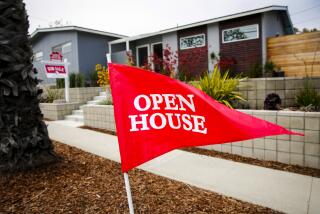Smart owners leave the house to its own devices
So-called connected homes, which feature a network of devices and appliances that communicate with each other and can be remotely monitored and controlled, are becoming increasingly popular and affordable.
By 2020, the connected home market could be worth nearly $150 billion globally, according to professional services firm PricewaterhouseCoopers. Most Americans surveyed by the company said that within the next decade, using a single remote to control everything in the home will be the norm.
“Younger generations view these devices as adding to the livability of the home,” said Mark Lesswing, chief technology officer for the National Assn. of Realtors trade group. “They’re early adopters now, but in three years, I think this becomes the norm.”
Coldwell Banker found that nearly half of the 4,000 people it recently polled already owned connected home products or planned to invest in some soon.
Most said they would implement the technology if it helped their homes sell faster once on the market. Of those, 65% said they would pay $1,500 or more for smart devices; 40% would shell out at least $3,000.
Adding in a $200 smart camera won’t result in a $5,000 premium on the selling price of the house, but it “definitely gives you a competitive edge in the market,” Lesswing said. “When two properties are tied, the one that is equipped is going to win,” he said.
Popular products include the Amazon Echo smart speaker, which employs a digital taskmaster called Alexa to play news briefings, set alarms, make to-do lists and control appliances on command. Samsung’s SmartThings products can send messages to mobile devices when a faucet is leaking, turn on a light when someone sits near a sensor and train doors to lock once closed.
Apple’s HomeKit platform uses the company’s voice-activated Siri personal assistant to track smart accessories and personalize settings. There’s also the Google-owned Nest family of Internet-connected thermostats, smoke detectors, security cameras and other compatible items.
And services such as IFTTT and Stringify enable users to lay down detailed orders such as “If my phone GPS says I am home, after 10 minutes turn the Nest temperature to 72 degrees.”
Below, some other connected home technology options:
Security and monitoring
Many customers gravitate toward multiuse products. The Maximus Smart Security Light ($179) looks like a porch fixture but can be switched on using a smartphone. It sends alerts when its camera detects movement, records footage and can scare away intruders via an audio function.
The Netatmo Presence is similar but can differentiate between people, animals and cars and can toggle between infrared night vision and floodlights.
The Ring Video doorbell ($199) is equipped with a high-definition camera that allows users to see who’s at the door, speak with delivery agents and receive warnings when there’s motion on the property.
Locks can also be networked. QuickLock’s DoorLock (from $170) ditches traditional keys and instead relies on mobile devices, key cards and fobs. Users can check logs of who has entered specific doors and assign temporary access.
Inside the house, the Canary ($199) security system relies on a 147-degree camera and night vision to monitor air quality, temperature, humidity and movement.
Temperature, lighting and energy management
To get the ambience in the home just so, there’s the Febreeze Home device ($79), which syncs via Nest with airflow from the ventilation system to spread scents. The Keen Smart Vent (from $72) manages temperatures in each room individually. Other popular options include the Nest Learning Thermostat ($249) and Ecobee3 ($249).
There’s also the Roost Smart Smoke Alarm ($80), which serves as a hard-wired and battery-powered smoke, natural gas and carbon monoxide detector. In an emergency, the device uses WiFi to notify the owner’s mobile device as well as specified friends and neighbors.
And lighting options are legion. The Bluetooth-enabled Playbulb Comet ($60) is an adhesive strip of LED lights that can change color settings, brightness and effects.
When homeowners are out, BeON Home bulbs ($199 for starter pack) mimic the property’s usual lighting patterns and turn on with the sound of a doorbell or alarm. The devices also provide backup light during power outages.
Appliances
In the kitchen,the Samsung Family Hub fridge (from $5,600) includes a 21.5-inch touch screen on the door that can display artwork, real-time images of the fridge’s contents, the food’s age and online grocery sites.
The Smarter Coffee Machine ($234) brews a cup of joe on a schedule, adjusts the flavor and notifies users when it’s out of water.
For other chores, Whirlpool offers the Smart Cabrio Top Load washer ($1,399) and dryer, which can be remotely started and paused. The appliance can specialize wash cycles for items such as swimwear and sleeping bags and track energy use. The Whirlpool mobile app syncs with Amazon for easy reordering of laundry supplies.
More to Read
Sign up for Essential California
The most important California stories and recommendations in your inbox every morning.
You may occasionally receive promotional content from the Los Angeles Times.










